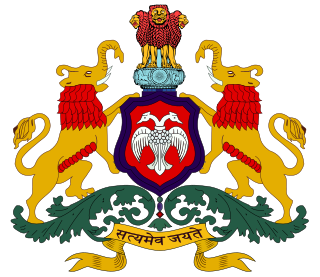Related Research Articles

India is a federal union comprising 28 states and 8 union territories, for a total of 36 entities. The states and union territories are further subdivided into districts and smaller administrative divisions.
The Indian Republic held its first elections in 1951–52.
The Madhya Pradesh High Court is the High Court of the state of Madhya Pradesh which is located in Jabalpur. It was established as the Nagpur High Court on 2 January 1936 by Letters Patent dated 2 January 1936, issued under Section 108 the Government of India Act, 1935. This Letters Patent continued in force even after the adoption of the constitution of India on 26 January 1950 by virtue of Articles 225 & 372 thereof. The court has a sanctioned judge strength of 53.

The Uttar Pradesh Legislative Council also known as Uttar Pradesh Vidhan Parishad is the upper house of the bicameral legislature of Uttar Pradesh, a state in India. Uttar Pradesh is one of the six states in India, where the state legislature is bicameral, comprising two houses: the Vidhan Sabha and the Vidhan Parishad. The Vidhan Parishad is a permanent House, consisting of 100 members.

The Tamil Nadu Legislative Assembly is the unicameral legislature of the Indian state of Tamil Nadu. It has a strength of 234 members, all of whom are democratically elected using the first-past-the-post system. The presiding officer of the Assembly is the Speaker. The term of the Assembly is five years, unless dissolved earlier.

The Karnataka Legislative Council is the upper house of the state legislature of Karnataka. Karnataka is one of six Indian states with a bicameral legislature; the Legislative Assembly is the lower house. The Council is a permanent body of 75 members, of whom 64 are elected in various ways in staggered elections and 11 are appointed by the Governor of Karnataka. Members hold their seats for six-year terms.
The Jammu and Kashmir Legislative Assembly also known as the Jammu and Kashmir Vidhan Sabha is the legislature of Indian union territory of Jammu and Kashmir.

The Madhya Pradesh Vidhan Sabha or the Madhya Pradesh Legislative Assembly is the unicameral state legislature of Madhya Pradesh state in India.

Elections to the Madhya Pradesh Legislative Assembly were held on 26 March 1952. 1,122 candidates contested for the 184 constituencies in the Assembly. There were 48 two-member constituencies and 136 single-member constituencies, for a total of 232 seats. The Indian National Congress won a majority of seats and Ravishankar Shukla became the Chief Minister.

Elections to the Rajasthan Legislative Assembly were held on 29 February 1952. 616 candidates contested for the 140 constituencies in the Assembly. There were 20 two-member constituencies and 120 single-member constituencies.

Elections to the Legislative Assembly of the Indian state of Vindhya Pradesh were held on March 26, 1952. 252 candidates contested the 48 constituencies in the Assembly. There were 12 two-member constituencies, and 36 single-member constituencies. The Indian National Congress won a majority of seats and Sambhu Nath Shukla became the new Chief Minister.
Elections to the Madhya Pradesh Legislative Assembly were held on 25 February 1957. 1,108 candidates contested for the 218 constituencies in the Assembly. There were 69 two-member constituencies and 149 single-member constituencies.

Located in Lucknow, the Vidhan Bhavan is the seat of the bicameral legislature of the Indian state of Uttar Pradesh. The lower house is the Vidhan Sabha and the upper house is called the Vidhan Parishad or the. The Vidhan Sabha had 431 members until 1967, but now comprises 403 directly elected members and one nominated member from the Anglo-Indian community. The Vidhan Parishad has 100 members.
Elections to the Madhya Pradesh Legislative Assembly were held in November 1998. The Indian National Congress won a majority of seats and Digvijaya Singh was sworn in as the new Chief Minister for the second time.
References
- ↑ "The States Reorganisation Act, 1956" . Retrieved 2022-11-17.
- 1 2 "Legislative Councils Act, 1957" . Retrieved 2022-11-17.
The total number of seats in the Legislative Council for the State of Madhya Pradesh to be constituted under section 33 of the States Reorganisation Act, 1956 (37 of 1956.), shall be increased from 72 as fixed by sub-section (2) of that section to 90.
- ↑ Verinder Grover (1989). Legislative Council in State Legislatures. Deep and Deep Publications. p. 35. ISBN 9788171001934 . Retrieved 2022-11-17.
- ↑ Chakshu, Roy (May 20, 2021). "Bengal wants Upper House back: how states have Councils , ,". PRS legislative research. Retrieved 21 Dec 2023.
- ↑ "Madhya Pradesh wants Legislative Council: what it entails". The Indian Express . 19 August 2019.